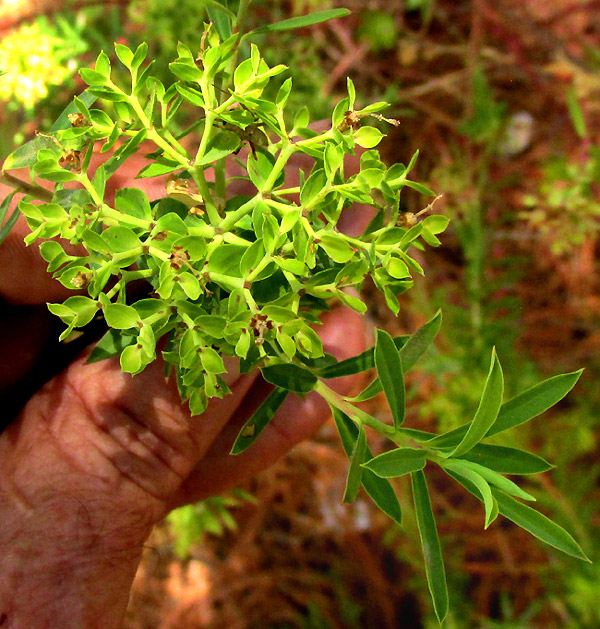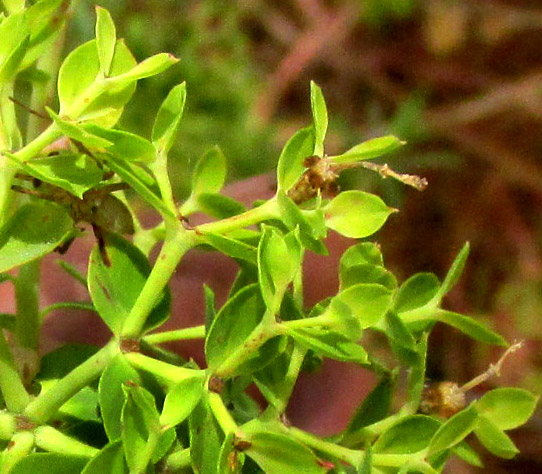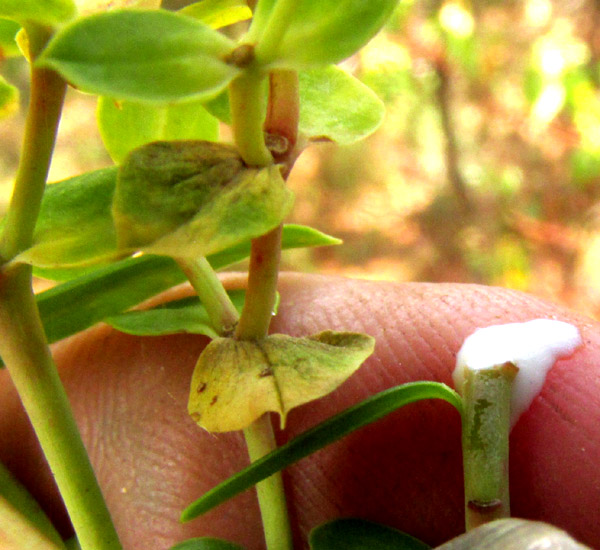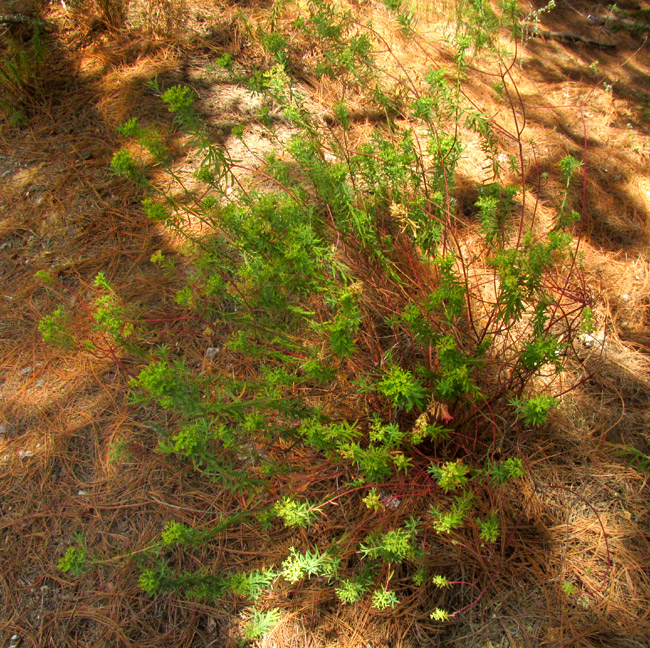Excerpts from Jim Conrad's
Naturalist Newsletter
Entry from field notes dated July 1, 2023, taken along road between El Campamento and El Doctor in mountains of east-central Querétaro state, municipality of Cadereyta de Montes, about 12 straight-line kms due east of Vizarrón de Montes but much farther by twisting roads; elevation ~2500m (~8200 ft), Querétaro, MÉXICO, (N20.87663°, W99.61187°)
TERRACINA SPURGE

Growing weedily along the road in a spot usually shaded by pines, a leg-tall perennial herb produced numerous stiff, slender stems from the base. Atop several stems grew interesting floral-like arrangements such as the above. That star-burst structure technically consists of "terminal pleiochasial branches." In other words, at a stem's top, a flowering structure began when two or more branches developed, then each of those branches divided two or more times, then those branches similarly branched, and this can go on for five or so branchings. Typically, in the crotch between the branches' bases, a single flowering occurs. In the above picture, the leafy stem directed toward the image's lower, right corner shows what leaves on the stem below the pleiochasial branchings look like. Note how different they are from the leaflike bracts appearing inside the branching structure.
Also note that near the flower arrangement's lower border where the leafy shoot arises, there's a tiny star-shaped item. That's a special kind of flower cluster called a cyathium. Cyathia are distinctive of just one group of plants known as spurges, of the Spurge Family, the Euphorbiaceae. Here's a close-up of another one, to the right of the spider:

The odd-looking item with brown, petal-like appendages is an old cyathium with its seeds already dispersed, for this plant has already passed through its flowering and fruiting season. A cyathium is a cuplike structure, the involucre, along the top rim of which occur 1-10 nectar glands, depending on the species. Our plant's cyathia bear four glands, which in the picture look like stubby, brown flower petals -- presumably brown because they're drying up. Inside the cyathium, earlier there were several extremely reduced male flowers, each consisting of a single pollen-producing stamen. Amid the male flowers arose the stalk of a single much reduced female flower. This female flower's ovary couldn't fit inside the cyathium cup, so the stalk held it well beyond the cup. In the above picture, two cyathia are seen, each with a long female-flower's stalk, at the tip of which there's a kind of node, and then a more slender item, which is what's left of the core of former fruit.

The above shows the white latex typical of spurges when a part is damaged. On the picture's left side, lower parts of the pleiochasial branching system produce leaf-like bracts much broader and shorter than stem leaves below flowering structure. Here's our plant along the road, in a spot usually shaded by pines:

The spurge genus Euphorbia is a huge one, embracing about 2000 species which range from tiny annuals up through Christmas Poinsettias, to trees 30m tall (nearly 100ft). In our highland, central Mexican region, if you have an erect, leg-tall spurge with cyathia arranged in pleiochasial branching structures such as our top picture shows, the cyathias' four nectar glands bear stubby, curved, petal-like appendages such as seen above, and at the point where branchings begin usually five or more primary branches develop, you have EUPHORBIA TERRACINA, variously called the Terracina Spurge, Carnation Spurge, False Caper and other names.
Finding Euphorbia terracina along this road is interesting because the plant is native to the Mediterranean region, but today is appearing as an invasive weed throughout much of the world, and not much recorded in Mexico. The Malezas de México website, Mexican Weeds, says that until now it's been observed easily establishing itself on dunes and other coastal sandy areas, and that there exists the possibility that it can become an invasive in other habitats here in Mexico. Our highland roadside across a steep limestone slope wasn't sandy, so maybe our plant is among the first to arrive in this region. It was first reported in Mexico in 1984, as announced in A. Radcliffe-Smith's 1984 work, "A New Introduciton to the Flora of Mexico." In the US, so far it's reported only from southern California.
In southern Australia, where Euphorbia terracina is known as the Geraldton Carnation Weed, the Victorian Resources Online website page for this species reports that its "Sap is highly caustic and can cause painful inflammations, temporary blindness, or permanent vision loss." The sap also deters native herbivores. The species is alleolopathic -- reduces seed germination of other plant species, thus can form dense thickets where it out competes native species for space, light and nutrients.
On the other hand, in southern Spain where Euphorbia terracina is native, traditionally it's been regarded as medicinal, as a drastic purgative and emetic -- makes you vomit and have a bowel movement. The white latex when applied to calluses and warts removes them. Since the latex turns the skin red and makes it burns, it's been used externally to treat rheumatic pains of the joints. In Egypt, where also it's native, Yasser A. El-Amier and others, noting that many disease-causing bacterial strains are becoming immune to synthesized medicines, in their 2016 study entitled "Evaluation of Antioxidant and Antimicrobial Activities of Euphorbia terracina L. from Deltaic Mediterranean Coast, Egypt," found that extracts of the plant exhibited appreciable broad spectrum effects against both gram-positive and gramnegative bacteria.